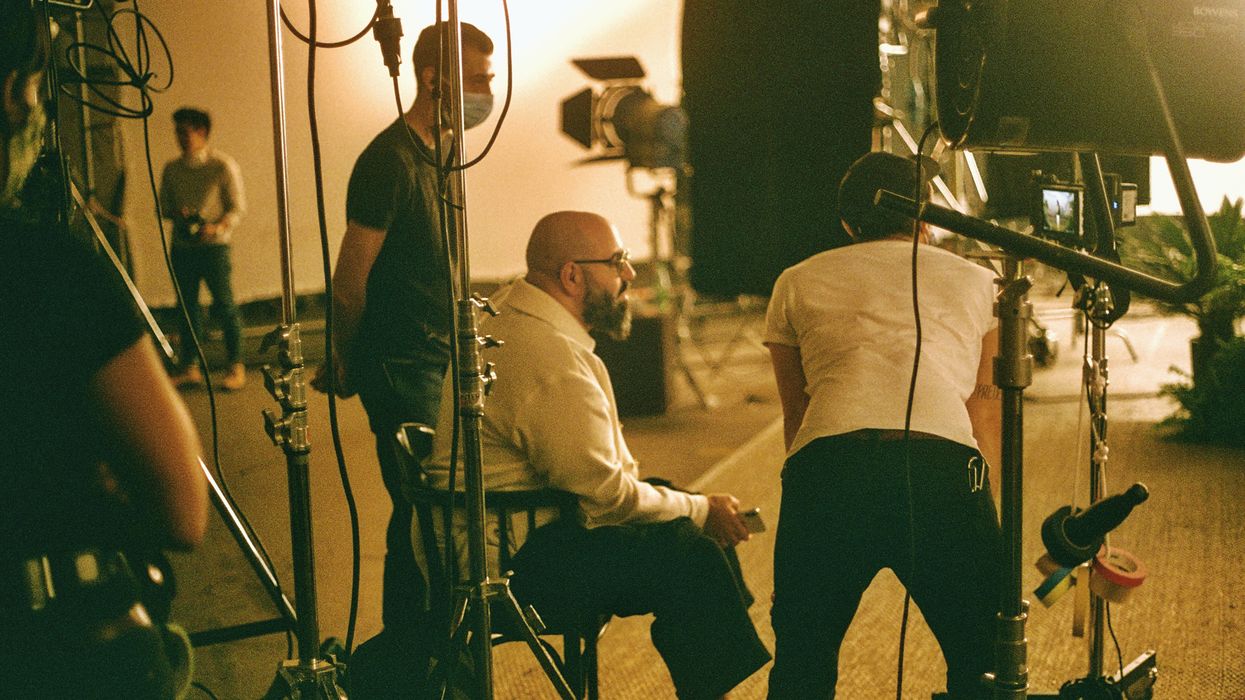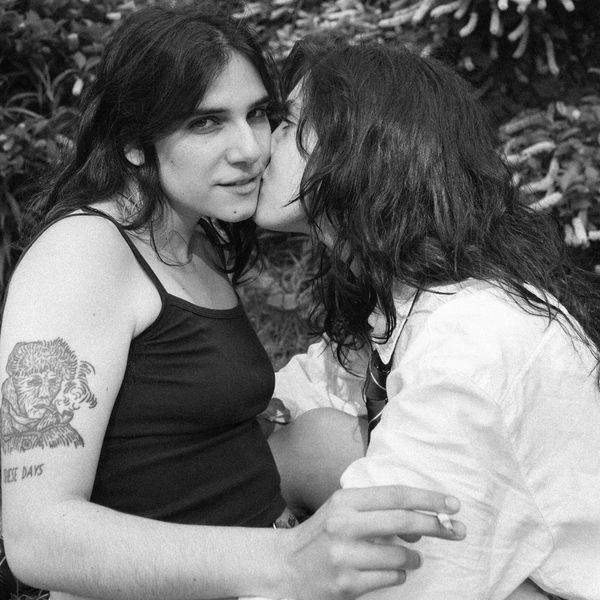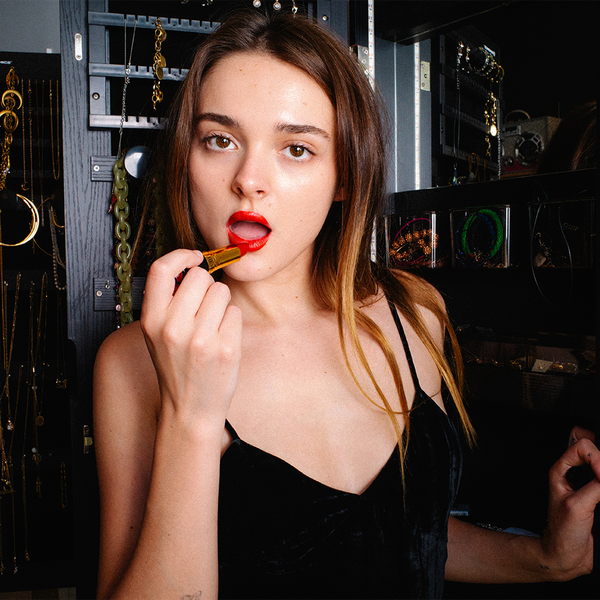Designers
Casablanca’s Charaf Tajer Designs Collections Wrought with Escapism
His first foray into womenswear takes us on a journey to the casinos and racetracks of Monaco.

26 January, 2021
10 November, 2021
The polarizing nature of 2020 has split the fashion world into two camps: those who see fashion as function versus those who embrace its illustrious power of escapism. Casablanca’s Charaf Tajer falls into the latter category, but not by way of the pandemic. Since launching the brand in 2018, the Parisian designer’s collections have taken us on a stimulating visual journey through the jungles of Hawaii, the cities of Morocco, or the beaches of Brazil—even the name Casablanca alludes to a transitional state captured in the 1942 film. Tajer’s autumn ’21 collection (launched January 23rd) transported us to Monaco, where the designer found inspiration amidst the feverish convergence of lovers, gamblers, tycoons, and race-car drivers.
In a move that prior collections almost alluded to, Tajer decided to accompany his menswear with a feminine counterpart this season. The same concepts flit between the men’s and women’s ensembles—a Harlequin diamond motif, precise tailoring, and tropical prints—but Tajer explains the Casablanca woman “is stronger than the Casablanca man.” Even when her garments are rendered in soft, fluid fabrics, the silhouettes are sharp, purposeful. “What is very important for me is to give strength and power aesthetically to a woman that doesn't need to be boyish,” he says, putting words to a growing movement in fashion that allows women to find power in femininity.
We were fortunate enough to catch up with Tajer ahead of the collection’s debut to pick his brain about his approach to design. Unlike many of his counterparts, his experience ranges to encompass industries outside of fashion—architecture, specifically, which now greatly informs his designs. “For me, design is all the same thing,” he explains. “It’s all based on the colors and proportions. Once you understand colors and proportions, you can literally design anything.” He invokes that same freedom in his refreshing outlook on his company, placing greater emphasis on creating what he desires versus catering to what he believes will sell. That said, he has still managed to capture a snapshot of the zeitgeist as we lust for hot nights dancing on an island.
In a move that prior collections almost alluded to, Tajer decided to accompany his menswear with a feminine counterpart this season. The same concepts flit between the men’s and women’s ensembles—a Harlequin diamond motif, precise tailoring, and tropical prints—but Tajer explains the Casablanca woman “is stronger than the Casablanca man.” Even when her garments are rendered in soft, fluid fabrics, the silhouettes are sharp, purposeful. “What is very important for me is to give strength and power aesthetically to a woman that doesn't need to be boyish,” he says, putting words to a growing movement in fashion that allows women to find power in femininity.
We were fortunate enough to catch up with Tajer ahead of the collection’s debut to pick his brain about his approach to design. Unlike many of his counterparts, his experience ranges to encompass industries outside of fashion—architecture, specifically, which now greatly informs his designs. “For me, design is all the same thing,” he explains. “It’s all based on the colors and proportions. Once you understand colors and proportions, you can literally design anything.” He invokes that same freedom in his refreshing outlook on his company, placing greater emphasis on creating what he desires versus catering to what he believes will sell. That said, he has still managed to capture a snapshot of the zeitgeist as we lust for hot nights dancing on an island.
You have a more diverse background than most in fashion. Working in areas outside of fashion, how does that affect design?
“For me, design is all the same thing. It’s all based on the colors and proportions. Once you understand colors and proportions, you can literally design anything.”
Teenage psychology can’t hurt either:
“Yes, but that’s more for dealing with people, I would say.”
Why did you start with menswear?
“I just wanted to do something that I didn’t see in the market. I wanted those clothes, but I could not find them, so I decided to create them for me at the beginning, then it becomes the brand.”
Anything that attracted you to menswear, as it’s less saturated than that of women’s?
“I’m not thinking like that. That kind of strategy doesn’t interest me. There is competition in everything, but it was a natural thing for me because at Pigalle we were doing menswear, so it was natural.”
“For me, design is all the same thing. It’s all based on the colors and proportions. Once you understand colors and proportions, you can literally design anything.”
Teenage psychology can’t hurt either:
“Yes, but that’s more for dealing with people, I would say.”
Why did you start with menswear?
“I just wanted to do something that I didn’t see in the market. I wanted those clothes, but I could not find them, so I decided to create them for me at the beginning, then it becomes the brand.”
Anything that attracted you to menswear, as it’s less saturated than that of women’s?
“I’m not thinking like that. That kind of strategy doesn’t interest me. There is competition in everything, but it was a natural thing for me because at Pigalle we were doing menswear, so it was natural.”
Was womenswear always in the plan?
“It’s always a dream, but I didn’t know I could achieve it so early.”
How would you describe the difference in design? Obviously you’re working with two different bodies, but other than that, is it largely the same?
“For me, it’s essentially the same because my approach to clothes is quite sensitive—what I imagine is what I do. I love to stick to what I believe in. My design process is really based on my projection and my ideas, so it’s basically the same process. But with women’s, it’s even more into details than men’s.”
Was there any strategy in your decision to show both at men’s fashion week?
“For me, it’s natural. I want the Casablanca womenswear to be supported by the Casablanca menswear at the beginning. One day, if our brand becomes bigger, of course we’ll have different shows, but that’s not essential because I like the idea of having the couple. There’s always been something very romantic to the story. In this show, it is important, very important, to have the boy by the woman’s side.”
“It’s always a dream, but I didn’t know I could achieve it so early.”
How would you describe the difference in design? Obviously you’re working with two different bodies, but other than that, is it largely the same?
“For me, it’s essentially the same because my approach to clothes is quite sensitive—what I imagine is what I do. I love to stick to what I believe in. My design process is really based on my projection and my ideas, so it’s basically the same process. But with women’s, it’s even more into details than men’s.”
Was there any strategy in your decision to show both at men’s fashion week?
“For me, it’s natural. I want the Casablanca womenswear to be supported by the Casablanca menswear at the beginning. One day, if our brand becomes bigger, of course we’ll have different shows, but that’s not essential because I like the idea of having the couple. There’s always been something very romantic to the story. In this show, it is important, very important, to have the boy by the woman’s side.”
Who is the Casablanca woman?
“The Casablanca woman? She’s stronger than the Casablanca man. I was raised by strong women. So they are my biggest inspiration, more than just aesthetically. Of course, the styles can change, the colors can change, the patterns can change, but what is very important is to give strength and power aesthetically to a woman that doesn’t need to be boyish. I think a woman can be very, very sexy and very feminine, but also be very strong. That’s the woman that I’m imagining.”
So many of your collections are inspired by places. What attracts you to a location as a sort of muse?
“I think one of the most beautiful things that the universe gives us on this planet is the ability to go and discover different places and different people. That’s my number one inspiration because I love how humans and nature blend together. Travel is my number one in any collection. This one is inspired by Formula One in Monaco and the casinos. That’s another trip that I did this year that I enjoyed because it’s quite a unique place. I always mix one sport, one travel, one idea, one identity, but whether it’s Brazil or Italy or Hawaii or this time Monaco, the DNA of the brand is still very much there.”
What do you think consumers want right now, or are you even concerned with that?
“I never think about what the customer wants. I always think about what I want, what I love, what my team wants, the story we want to say. I don’t think it’s a good idea to go check data because every time you check the data, it will change the day after, but feelings don’t change. The feelings, the love stories, the travel, the laughs, the sadness, the beauty—all of this doesn’t change. I think I understand why certain people do it, but personally, it’s not the way that I work. It’s not what I want to say. I want to give stories to people, not take their money.”
“The Casablanca woman? She’s stronger than the Casablanca man. I was raised by strong women. So they are my biggest inspiration, more than just aesthetically. Of course, the styles can change, the colors can change, the patterns can change, but what is very important is to give strength and power aesthetically to a woman that doesn’t need to be boyish. I think a woman can be very, very sexy and very feminine, but also be very strong. That’s the woman that I’m imagining.”
So many of your collections are inspired by places. What attracts you to a location as a sort of muse?
“I think one of the most beautiful things that the universe gives us on this planet is the ability to go and discover different places and different people. That’s my number one inspiration because I love how humans and nature blend together. Travel is my number one in any collection. This one is inspired by Formula One in Monaco and the casinos. That’s another trip that I did this year that I enjoyed because it’s quite a unique place. I always mix one sport, one travel, one idea, one identity, but whether it’s Brazil or Italy or Hawaii or this time Monaco, the DNA of the brand is still very much there.”
What do you think consumers want right now, or are you even concerned with that?
“I never think about what the customer wants. I always think about what I want, what I love, what my team wants, the story we want to say. I don’t think it’s a good idea to go check data because every time you check the data, it will change the day after, but feelings don’t change. The feelings, the love stories, the travel, the laughs, the sadness, the beauty—all of this doesn’t change. I think I understand why certain people do it, but personally, it’s not the way that I work. It’s not what I want to say. I want to give stories to people, not take their money.”
Your designs are so joyful. Are you as optimistic about the industry?
“Fashion is a form of art, like paintings or music or architecture. Who am I to judge the industry? I think we need to be more sustainable, obviously, but for me, it’s a form of art that I am practicing, and that’s all I see.”
As someone that finds inspiration in heritage brands, how do you combat the stereotype that they cater to an older clientele and design a brand that attracts everyone?
“As I told you, I believe in stories. I believe in feelings. You do what you want and people love it or they hate it, but at least you get noticed. Heritage brands, they’re not for old people. For me, the great brands are the ones everybody can wear. That’s why I want Casablanca to be worn by everyone, not by only a certain category of people or a certain demographic. Everybody wears CHANEL because CHANEL is the best. It speaks to everyone. The classic brands are not only speaking to an older demographic, and that’s why I want Casablanca to become a classic in the Parisian landscape.”
How do you design timeless pieces when our lifestyles are changing so rapidly?
“It’s about creating assets that people can collect, that they won’t just wear for a season. That’s the most important thing for me. You were talking about the classic brands, the biggest trend they have is to create something that you can give to your daughter or to your granddaughter one day. That’s what I am aiming for with Casablanca.”
Where do you see your brand in 10 or 20 years?
“In 20 years I want people to say this is a Casablanca vintage. I want people to look at this brand as a classic.”
Top photo: Courtesy of Casablanca
Want more stories like this?
Meet Harry Lambert: The Stylist Using Fashion to Start a Dialogue
Styling Tricks to Aid in Our Search of a Seasonless Wardrobe
Designers Everywhere Are Reinventing the Shrug for 2021
“Fashion is a form of art, like paintings or music or architecture. Who am I to judge the industry? I think we need to be more sustainable, obviously, but for me, it’s a form of art that I am practicing, and that’s all I see.”
As someone that finds inspiration in heritage brands, how do you combat the stereotype that they cater to an older clientele and design a brand that attracts everyone?
“As I told you, I believe in stories. I believe in feelings. You do what you want and people love it or they hate it, but at least you get noticed. Heritage brands, they’re not for old people. For me, the great brands are the ones everybody can wear. That’s why I want Casablanca to be worn by everyone, not by only a certain category of people or a certain demographic. Everybody wears CHANEL because CHANEL is the best. It speaks to everyone. The classic brands are not only speaking to an older demographic, and that’s why I want Casablanca to become a classic in the Parisian landscape.”
How do you design timeless pieces when our lifestyles are changing so rapidly?
“It’s about creating assets that people can collect, that they won’t just wear for a season. That’s the most important thing for me. You were talking about the classic brands, the biggest trend they have is to create something that you can give to your daughter or to your granddaughter one day. That’s what I am aiming for with Casablanca.”
Where do you see your brand in 10 or 20 years?
“In 20 years I want people to say this is a Casablanca vintage. I want people to look at this brand as a classic.”
Top photo: Courtesy of Casablanca
Want more stories like this?
Meet Harry Lambert: The Stylist Using Fashion to Start a Dialogue
Styling Tricks to Aid in Our Search of a Seasonless Wardrobe
Designers Everywhere Are Reinventing the Shrug for 2021




